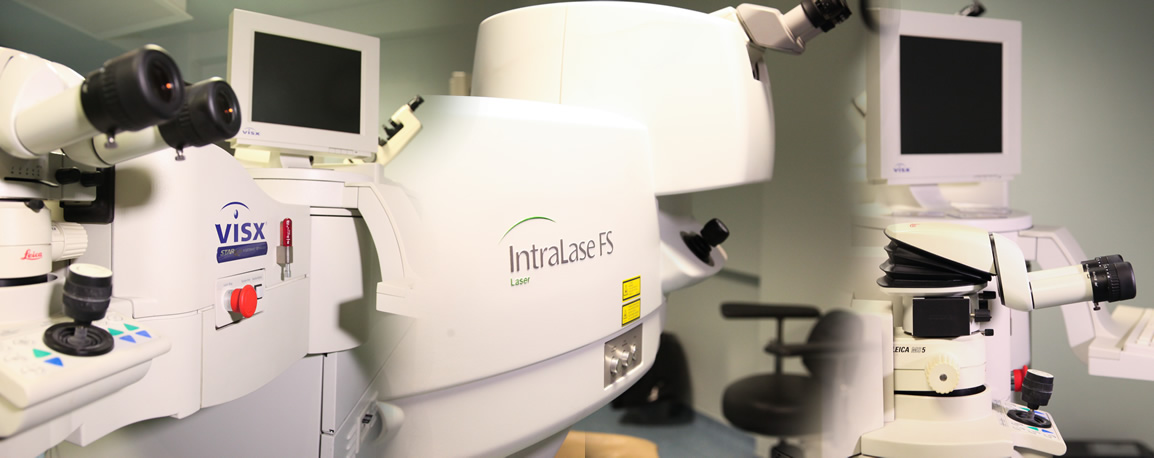Operation Procedure

Step 1: Pre-operative Check
Probably the most crucial phase since all the required examinations are carried out to determine whether it is completely safe to proceed to a laser operation and which one of the available methods is the most appropriate. The duration of the examination is approximately one hour and includes a full Refractive Check, Eye Biomicroscopy, Corneal Topography, Ocular Aberrations Analysis (wavescan) Corneal Pachymetry (pachymetry of the corneal epithelium layer with the corresponding maps to monitor subclinical keratoconus), Intraocular Pressure Measuring, Fundoscopy.
Step 2: Method Selection
When your preoperative check is concluded, your surgeon / ophthalmologist, having all the examinations’ results at hand will suggest the best and most secure methods for your case. The specific vision needs and activities of each patient will determine the option chosen in the end. If laser is ultimately considered to be the appropriate method and given the patient’s consent, a date and time for the operation is proposed and then the patient is informed about the cost and any special offers available.
Step 3: Surgery Day
Preparation:
The day appointed for the laser, the patient is asked to come to the clinic 45 minutes before the time set for the operation. It is recommended that the patient be accompanied by a relative or friend to avoid driving upon completion of the surgery. After the necessary preparation by the nurse, the patient is led to the laser operating site. The nurse makes all necessary preparations for the laser and guides the patient step-by-step.
Anesthesia:
Only local anesthesia is administered and is implemented exclusively with eye drops, without the need for an injection. Upon the patient’s request, there is the possibility of a mild oral sedative.
Operation:
The ophthalmologist/surgeon will guide you during the operation procedure. Initially, you will be asked to lie on a special bed and with the aid of a special tool your eyes will remain open, stabilizing eyelids and without you feeling any discomfort, so you do not need worry about it. Then you will need to focus your gaze to a certain target, nevertheless if something distracts you, the multiple sensors that are employed in the laser will automatically terminate the process in milliseconds. After instilling antiseptic drops, the doctor places a special protective cover. You will continue to focus at the target. If LASIK method has been selected, first the Femtosecond laser will be implemented, in which the flaps will be created, and then the Excimer laser will follow which will remove any refractive error (myopia, hyperopia, astigmatism, presbyopia). The duration of each laser is only a few seconds, during which you will probably hear a faint sound, which basically originates from the function of the laser. You will not feel the slightest pain, just a feeling that the surgeon is performing the operative procedure in your eye area. Throughout the process you will be in an open communication with all medical staff, while you can even request the termination of the process. After the process is concluded, special antibiotic drops will be instilled and a therapeutic contact lens will be placed that will have to remain in the eye from 2 to 5 days, and then will be removed by your ophthalmologist. Both eyes will undergo surgery on the same day.
Step 4: Immediately after the conclusion of surgery
Upon completion of the operation you will stay for a period of about thirty minutes in the recovery room, along with the person accompanying you, to unwind and relax. The ophthalmologist or nurse will give you postoperative instructions that you have to follow and will then provide you with the necessary eye drops. Depending on the laser method you selected, it is possible to feel some discomfort. Nevertheless, you will have medication and drops to treat and mitigate any pain. In general, the recovery of LASIK is smoother than that of PRK / LASEK, but all methods lead to the same successful results, so the choice of the appropriate technique will be made considering patient safety. Finally, you will be given a special protective mask for optional use during sleep.
Step 5: The first postoperative week
The ophthalmologist will examine you the next day after your operation. During the first three days you may feel some discomfort, like the sense that there is a foreign body in your eye, irritation, photophobia and tearing. Note that patients undergoing the PRK / LASEK technique are normally experiencing more of these symptoms compared to those who opt for LASIK. Vision is gradually restored and, generally, the LASIK produces faster results. According to the post-operative course of the patient, a follow-up meeting will be scheduled with the physician, normally between the third and fifth days, during which the therapeutic lens is removed.
Step 6: Weekly examination
You will undergo a microscopic examination by your ophthalmologist to verify that everything all is well and you will be given further instructions.
Step 7: Monthly examination
During this examination, the doctor makes a comprehensive assessment of the overall results. The ophthalmologist performs an examination of the patient under the microscope, performs topography and assesses the outcome of the laser surgery. However, there are cases where a further period of time is required (up to three months) to make a final assessment of the result.


